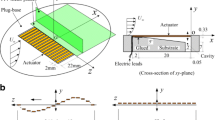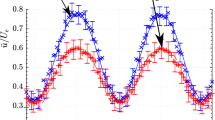Abstract
This paper reports the modifications of near-wall low-speed streaks by local surface oscillations generated by a spanwise-aligned actuator array in a turbulent boundary layer over a flat plate at Re θ = 1,000. The streaks were educed from PIV-measured fluctuating velocities in the viscous sublayer using a procedure proposed by Schoppa and Hussain (2002). The wall-based perturbations, corresponding to a large skin-friction drag reduction (about 50 % at 17 wall units downstream of the actuator array), modified greatly the low-speed streaks, leading to a reduction by over 15 % in both the averaged width and spacing while an increase by 17 % in the streak center number. The alterations of velocity streak distributions are consistent with results from other techniques such as smoke-wire flow visualization and two-point cross-correlation, where the breakup of large-scale coherent structures into small-scale ones was observed.
Access provided by Autonomous University of Puebla. Download conference paper PDF
Similar content being viewed by others
Keywords
1 Introduction
Active control of turbulent boundary layers (TBLs) for skin-friction drag reduction has been received a great deal of attention in fluid dynamics research community due to its significance in engineering applications. It has been widely accepted that large-scale coherent structures in the near-wall region of a TBL is closely connected to large skin-friction drag. Thus, manipulating these structures may affect the skin-friction drag. Recently, Bai et al. (2012) employed a spanwise-aligned PZT actuator array generating local surface perturbations to disturb the streaky structures. Under the optimum control parameters, they achieved a large reduction in local skin-friction drag by 50 % at 17 wall units downstream of the actuator array while observed a significant impairment of large-scale coherent structures. The alterations of near-wall flow structures by this technique were carefully examined based on extensive measurements via smoke-wire flow visualization, hotwire, hot-film, and PIV techniques. The present work aims to further study the modifications of near-wall structures based on PIV-measured fluctuating velocities in the viscous sublayer using a velocity streak eduction procedure proposed by Schoppa and Hussain (2002).
2 Experimental Details
Experiments were conducted in a closed-circuit wind tunnel with a 2.4-m-long test section of 0.6 × 0.6 m. With the leading edge tripped, a flat plate placed horizontally in the tunnel was used to produce a fully developed TBL. As shown in Fig. 1a, one array of 16 PZT actuators was deployed at 1.5 m downstream of the leading edge of the plate. Each actuator, having a dimension of 22 × 2 × 0.33 mm (length × width × thickness), was flush-mounted with the plate surface. The actuators are cantilever-supported, with its inactive part (2 mm long) glued to a substrate, which is embedded in a circular plug-base. There is a cavity under each actuator so that the active part (20 mm long) of the actuator can vibrate freely. The spacing between two adjacent actuators is 1 mm. All actuators will generate individual wall-normal oscillations when driven by a sinusoidal voltage and, given a phase shift (φ i,i+1 ) between two adjacent elements, a transverse travelling wave on the wall surface (Fig. 1b). At the actuation location, the TBL has a momentum thickness θ = 6.5 mm, given a free-stream velocity U ∞ = 2.4 m/s, and a Reynolds number Re = 1,000 based θ and U ∞ . The origin of the coordinate system is at the actuator tip, with the x-, y-, and z-axes along the streamwise, normal, and spanwise directions, respectively (Fig. 1).
PIV measurements of fluctuating velocity (u +) in the xz-plane of y + = 5.5 were conducted for the natural and disturbed flows. For the latter case, the actuators were operated under the optimum parameters, i.e., \( A_{o}^{ + } = 2.22 , \) \( f_{o}^{ + } = 0.65 , \) and φ i, i+1 = 18o, where \( A_{o}^{ + } \) is the peak-to-peak oscillation amplitude at the actuator tip and \( f_{o}^{ + } \) is the oscillation frequency, corresponding to the maximum drag reduction of 50 % at x + = 17. Unless otherwise stated, superscript ‘+’ denotes normalization based on the wall variables in the absence of control. The PIV image covers an area of x + = 0–306 and z + = ±153. Spatial cross-correlation, with an interrogation window of 64 × 64 pixels and a 50 % overlap along both directions, was calculated to determine velocity vectors. Over 2,000 pairs of images were taken during the measurements.
3 Results and Discussions
Table 1 presents a comparison of the statistical results from the streak eduction between the natural and controlled flows, i.e., identified low-speed streak center numbers N, and averaged low-speed streak spacing \( \bar{S}^{ + } \) and width \( \bar{L}^{ + } . \) The number of low-speed streak centers was increased by about 17 %, while the averaged width and spacing were reduced by 15.5 and 17.3 %, respectively, by the wall-based oscillations.
Figure 2 shows histograms of the low-speed streak spacing S + and width L + with and without control. The distributions of S + (Fig. 2a) and L + (Fig. 2b) were greatly modified by the local surface oscillations. In the absence of control, the histogram of S + shows a positively skewed distribution, with the highest value at S + ≈ 60. Under control, the S +-distribution was more positively skewed, with its maximum shifted toward smaller S + (≈50). For the low-speed streak width, the highest probability occurs at L + ≈ 30 in the natural flow but is shifted toward smaller L + under control, suggesting impaired streaks. The observations are in line with results from smoke-wire flow visualization (Fig. 3) and two-point cross-correlation function R uu of u (Fig. 4). Large-scale coherent structures appear broken up, resulting in considerably smaller-scale longitudinal structures (Fig. 3). R uu in Fig. 4 indicates that lateral integral scale (areas under the curve) of the streaks was reduced by the wall-based oscillations.
Figure 5 shows the histograms of \( {{\partial u^{ + } } \mathord{\left/ {\vphantom {{\partial u^{ + } } {\partial x^{ + } }}} \right. \kern-0pt} {\partial x^{ + } }} \) and \( {{\partial u^{ + } } \mathord{\left/ {\vphantom {{\partial u^{ + } } {\partial z^{ + } }}} \right. \kern-0pt} {\partial z^{ + } }} \) at the streak borders with and without control, which characterize the internal shear layer and streamwise vortex generation. The histogram (Fig. 5a) appears positively skewed in the absence of oscillations, due to the fact that the magnitude of positive \( {{\partial u^{ + } } \mathord{\left/ {\vphantom {{\partial u^{ + } } {\partial x^{ + } }}} \right. \kern-0pt} {\partial x^{ + } }} \) decreases across the streak border when fluid particles move from the inside to outside of a low-speed streak. Once the control was introduced, the histogram is more symmetrical, which is attributed to the occurrence of less coherent structures in the disturbed flow and thus consistent with observations from the flow visualization (Fig. 3). The higher probability of large \( \left| {{{\partial u^{ + } } \mathord{\left/ {\vphantom {{\partial u^{ + } } {\partial x^{ + } }}} \right. \kern-0pt} {\partial x^{ + } }}} \right| \) in the histogram tails in the disturbed flow suggests that the low-speed streaks become less aligned with the streamwise flow and probably more wavy, compared to the natural case.
Histograms of \( {{\partial u^{ + } } \mathord{\left/ {\vphantom {{\partial u^{ + } } {\partial x^{ + } }}} \right. \kern-0pt} {\partial x^{ + } }} \) (a) and \( {{\partial u^{ + } } \mathord{\left/ {\vphantom {{\partial u^{ + } } {\partial z^{ + } }}} \right. \kern-0pt} {\partial z^{ + } }} \) (b) at streak borders: filled square, natural; empty square, controlled
The histogram of \( {{\partial u^{ + } } \mathord{\left/ {\vphantom {{\partial u^{ + } } {\partial z^{ + } }}} \right. \kern-0pt} {\partial z^{ + } }} \) (Fig. 5b) was modified by the wall-based oscillations, with the distribution mainly shifted to larger \( \left| {{{\partial u^{ + } } \mathord{\left/ {\vphantom {{\partial u^{ + } } {\partial z^{ + } }}} \right. \kern-0pt} {\partial z^{ + } }}} \right| \) compared to the natural case. The \( \left| {{{\partial u^{ + } } \mathord{\left/ {\vphantom {{\partial u^{ + } } {\partial z^{ + } }}} \right. \kern-0pt} {\partial z^{ + } }}} \right| \) at the streak borders is an indicator of the streak strength. Thus, the alteration of \( {{\partial u^{ + } } \mathord{\left/ {\vphantom {{\partial u^{ + } } {\partial z^{ + } }}} \right. \kern-0pt} {\partial z^{ + } }} \) histogram in Fig. 5b suggests an increase in streak strength and an indication of strong formation of streamwise vortices due to the wall-based oscillations. This feature is distinct from that using other techniques (Du et al. 2002).
4 Conclusions
The turbulent boundary layer is manipulated based on wall-normal oscillations generated by an array of 16 piezo-ceramic actuators flush-mounted to the wall surface; driven by a sinusoidal voltage, each oscillated independently and produced a perturbation to the flow. The maximum drag reduction reaches 50 % at x + = 17 under the optimum control parameters for the first time using an array of discrete actuators. The low-speed streaks in the viscous sublayer of this manipulated flow have been examined and detected based on PIV-measured u + of y + = 5.5. It has been found that the streaks decrease by over 15 % in width and spacing, though their strength is increased, in distinct contrast with the observation by others.
References
Bai HL, Zhou Y, Zhang WG, Xu SJ et al (2012) Active control of turbulent boundary layer based on local surface perturbation. J Fluid Mech (submitted)
Du Y, Symeonidis V, Karniadakis GE (2002) Drag reduction in wall-bounded turbulence via a transverse travelling wave. J Fluid Mech 457:1–34
Schoppa W, Hussain F (2002) Coherent structure generation in near-wall turbulence. J Fluid Mech 453:57–108
Acknowledgments
This work is supported by grants PolyU 5329/11E (HKSAR) and 11172085 (NSFC).
Author information
Authors and Affiliations
Corresponding author
Editor information
Editors and Affiliations
Rights and permissions
Copyright information
© 2014 Springer-Verlag Berlin Heidelberg
About this paper
Cite this paper
Bai, H.L., Zhou, Y., Zhang, W.G. (2014). Streaky Structures in a Controlled Turbulent Boundary Layer. In: Zhou, Y., Liu, Y., Huang, L., Hodges, D. (eds) Fluid-Structure-Sound Interactions and Control. Lecture Notes in Mechanical Engineering. Springer, Berlin, Heidelberg. https://doi.org/10.1007/978-3-642-40371-2_19
Download citation
DOI: https://doi.org/10.1007/978-3-642-40371-2_19
Published:
Publisher Name: Springer, Berlin, Heidelberg
Print ISBN: 978-3-642-40370-5
Online ISBN: 978-3-642-40371-2
eBook Packages: EngineeringEngineering (R0)









